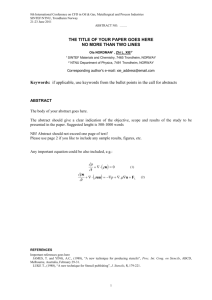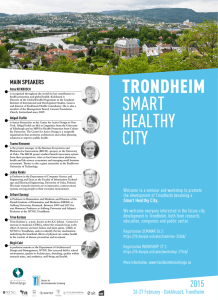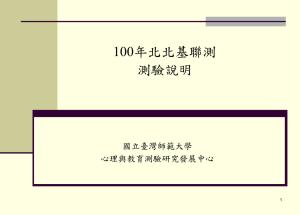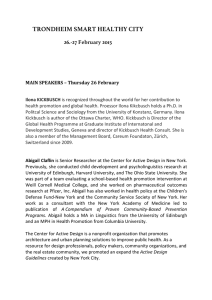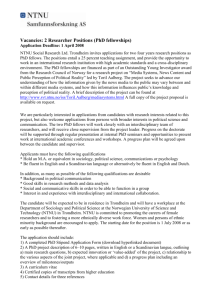Lecture notes on institutional theory
advertisement
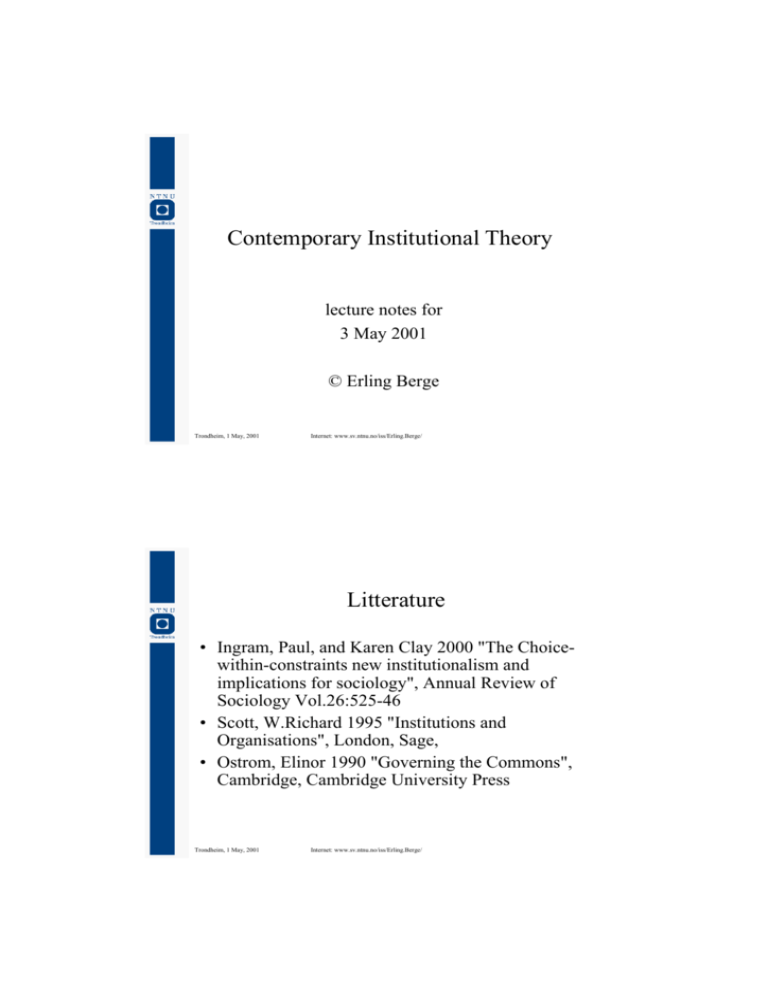
Contemporary Institutional Theory
lecture notes for
3 May 2001
© Erling Berge
Trondheim, 1 May, 2001
Internet: www.sv.ntnu.no/iss/Erling.Berge/
Litterature
• Ingram, Paul, and Karen Clay 2000 "The Choicewithin-constraints new institutionalism and
implications for sociology", Annual Review of
Sociology Vol.26:525-46
• Scott, W.Richard 1995 "Institutions and
Organisations", London, Sage,
• Ostrom, Elinor 1990 "Governing the Commons",
Cambridge, Cambridge University Press
Trondheim, 1 May, 2001
Internet: www.sv.ntnu.no/iss/Erling.Berge/
Introduction
• What is an institution?
• Previous theories
• Contemporary theory
– "Choice-within-constraints" perspective
– Cognitive-constructionist perspective
• Institutional change
– Origin
– Maintenance and reproduction
Trondheim, 1 May, 2001
Internet: www.sv.ntnu.no/iss/Erling.Berge/
Defining Institutions
Institutions comprise
– a substantive area of operation (field)
– a system of legitimate rules
– a group of persons with legitimate interest in the
interpretation and application of the rules
– a group of actors pursuing their goals within the
substantive area
Trondheim, 1 May, 2001
Internet: www.sv.ntnu.no/iss/Erling.Berge/
Previous theories
• 1880-1950
– Economics (Veblen, Commons, Schumpeter, Galbraith,
Myrdal) -->
• Overtaken by neo-classical micro-economics
– Political science ( most, but Burgess, Wilson,
Willoughby) -->
• Overtaken by behaviorism
– Sociology (most, but Weber, Durkheim, Cooley, Meade,
Hughes, Parsons) -->
• Dominated by conflict and class theory
Trondheim, 1 May, 2001
Internet: www.sv.ntnu.no/iss/Erling.Berge/
Neo-institutional theory
• 1950 ---->
– Economics (Coase 1937, 1960, Williamson 1975,
North& Thomas 1973, North 1990)
– Political science (March& Olsen 1984, 1989, Skocpol
1985, 1992, Buchanan& Tullock 1962, Shepsle&
Weingast 1987
– Sociology (Goffmann, 1961, Schutz 1962, Berger&
Luckmann 1967, Silvermann 1971, Meyer& Rowan
1977, Zucker 1977, DiMaggio& Powell 1983, Hechter
1987, Coleman 1990)
Trondheim, 1 May, 2001
Internet: www.sv.ntnu.no/iss/Erling.Berge/
Contemporary theory
• Cognitive
– Constructivist, institutional facts,Thomas theorem
• Normative
– Encoding shared values, shaping roles
• Regulative
– Coordination, collective action, affecting cost/benefit
calculations
Trondheim, 1 May, 2001
Internet: www.sv.ntnu.no/iss/Erling.Berge/
Three pillars of institutions (Scott 1995:35)
Regulative
Normative
Cognitive
Basis of
compliance
Expedience
Social
obligation
Taken for
granted
Mechanisms
Coercive
Normative
Mimetic
Logic
Instrument-ality Appropriateness
Orthodoxy
Indicators
Rules, laws,
sanctions
Certification
accreditation
Prevalence
isomorphism
Basis of
legitmacy
Legaly
sanctioned
Morally
governed
Culture,
knowledge
Trondheim, 1 May, 2001
Internet: www.sv.ntnu.no/iss/Erling.Berge/
Institutional carriers(Scott 1995:52)
Pillar
Carrier
Regulative
Normative
Cognitive
Cultures
Rules,
Laws
Values,
expectations
Categories,
typifications
Social
structures
Governance,
power sys
Regimes,
authority sys
Identities,
isomorphism
Routines
Protocols,
standard
procedures
Conformity,
performance of
duty
Scripts,
performance
programs
Trondheim, 1 May, 2001
Internet: www.sv.ntnu.no/iss/Erling.Berge/
Institutions:
where do they come from?
• Creating and changing: politics
– Dynamics
• Regulative -collective action problems
• Normative - encoding values
• Cognitive - defining (thought) worlds
– Statics
• Regulative - variable governance(market vs hierarchy)
• Normative - uncertainty in markets (fairness)
• Cognitive - standardization, belief systems
Trondheim, 1 May, 2001
Internet: www.sv.ntnu.no/iss/Erling.Berge/
Institutions:
how do they persist?
• Inertia is no explanation
• Maintenance and reproduction
–
–
–
–
–
–
–
Power and interests
Knowledge systems and shared norms
Environmental change
Network constraints
Framing effects
Diffusion (legitimity, expert knowledge)
Immitation, adoption
Trondheim, 1 May, 2001
Internet: www.sv.ntnu.no/iss/Erling.Berge/
Institutions:
shaping systems & fields
• The state
– Property rights
• The professions
– Cognitive and normative environments (the Thomas
theorem at group level)
• Shaping policy
– Economic, industrial, market, environment
Trondheim, 1 May, 2001
Internet: www.sv.ntnu.no/iss/Erling.Berge/
Institutions:
shaping fields & populations
• Creating fields
– boundaries, governance, structuration
• Forming populations
– Densities & legitimacy
– Certification, regulation, mandating
– Legitimacy (cognitive, normative, regulative)
Trondheim, 1 May, 2001
Internet: www.sv.ntnu.no/iss/Erling.Berge/
Organizations: structure&performance
• 'Imprinting' at establishment
– Culture, roles, beliefs, legitimacy
• Differential responses to pressures
– Collective (lobbying, compliance mechanisms)
– Individual (acquiescing, compromising, avoiding,
defying, and manipulating)
• Learning from others
• Of similar size
• Having success
Trondheim, 1 May, 2001
Internet: www.sv.ntnu.no/iss/Erling.Berge/
Summarizing
Institutions and organisations
• What is the difference?
• Co-evolution of institutions and organisations
• Level of analysis
Trondheim, 1 May, 2001
Internet: www.sv.ntnu.no/iss/Erling.Berge/
Organisations
•
•
•
•
Actors
Goals - preferences - utility
The relation between actor and goal
Action and action environment
–
–
–
–
governance
rights and duties
processes
externalities
Trondheim, 1 May, 2001
Internet: www.sv.ntnu.no/iss/Erling.Berge/
Who are entitled to appropriate?
Types of actors
• INDIVIDUALS
• COLLECTIVES
• the firm
• the association
• the community
• STATES
Trondheim, 1 May, 2001
Internet: www.sv.ntnu.no/iss/Erling.Berge/
Types of institutions
•
•
•
•
Private decentralised (persons)
Private centralised (collectives)
Public decentralised (cultures)
Public centralised (states)
Trondheim, 1 May, 2001
Internet: www.sv.ntnu.no/iss/Erling.Berge/
Problem areas for the theory
•
•
•
•
•
Rationality - bounded or?
Opportunism - trust
Credible commitment - contact enforcement
Transaction costs
Preferences - from where do they come?, and to
what do they apply?
Trondheim, 1 May, 2001
Internet: www.sv.ntnu.no/iss/Erling.Berge/
Scott(1995:33) defines Institutions
• consist of cognitive, normative, and regulative
structures and activites that provide stability and
meaning to social behavior. Institutions are
transported by various carriers - cultures, structures,
and routines - and they operate at multiple levels of
jurisdictions
Trondheim, 1 May, 2001
Internet: www.sv.ntnu.no/iss/Erling.Berge/
Rule systems
• Rules are based on values
– Cultural, social, economic
• Rules are based on knowledge
– Institutional facts
• Rules are based on needs for coordination
– Solving social dilemmas
• Persons have knowledge and values: usually in the
form of a world view shaping their perceptions of
facts and interpretation of rules
Trondheim, 1 May, 2001
Internet: www.sv.ntnu.no/iss/Erling.Berge/
Rule enforcement
• Monitoring and enforcement
– Second party enforcement ('victim')
– Third party enforcement ('state')
• Conflict resolution mechanisms
Trondheim, 1 May, 2001
Internet: www.sv.ntnu.no/iss/Erling.Berge/
Public centralized institutions
• Facilitating exchange (helping subjects to make
credible commitment)
• State commitment to abstain from subsidization of
organisations
• State commitment to abstain from "expropriation"
of property
• Regulation of distributional issues
Trondheim, 1 May, 2001
Internet: www.sv.ntnu.no/iss/Erling.Berge/
Public decentralized institutions
• Language
• Culture
• International law
Trondheim, 1 May, 2001
Internet: www.sv.ntnu.no/iss/Erling.Berge/
Private centralized institutions
• Governing property rights
– Claim's clubs, cattlmen's associations
– Commons
• Governing transactions
– Law merchant
– Certification schemes
• Organisations
– Firms
Trondheim, 1 May, 2001
Internet: www.sv.ntnu.no/iss/Erling.Berge/
Private decentralized institutions
• Informal conflict resolution
• Reputation and group pressures
• Foundational for other institutions (embeddedness ,
legitimacy , cognitive systems)
Trondheim, 1 May, 2001
Internet: www.sv.ntnu.no/iss/Erling.Berge/
Analytical levels of institutions
• The practical: Operational choices
• The organisational: Collective choices
• The constitutional: Constitutional
choices
Trondheim, 1 May, 2001
Internet: www.sv.ntnu.no/iss/Erling.Berge/
The Practical Level
• Application of rules to activites
• The everyday interpretation of operational rules by
individuals or groups assigned tasks by an
organisation
• The Lifeworld
Trondheim, 1 May, 2001
Internet: www.sv.ntnu.no/iss/Erling.Berge/
The Organisational Level
• Making rules about activties
• The day to day monitoring, evaluation and
adaptation of rules of operation for production and
distribution
• Law, Police, and Judiciary
Trondheim, 1 May, 2001
Internet: www.sv.ntnu.no/iss/Erling.Berge/
The Constitutional level
• “Rules about the making of rules”
• Constitution: Rules and procedures used to direct
and shape the internal activity of an organisation
and the rules of its operation
• The “Legislature” of the Organisation
Trondheim, 1 May, 2001
Internet: www.sv.ntnu.no/iss/Erling.Berge/
Sources of variation in instituions
•
•
•
•
Governance (market vs hierarchy)
Incentives (rights and duties)
Processes (by types of goods)
Externalities
Trondheim, 1 May, 2001
Internet: www.sv.ntnu.no/iss/Erling.Berge/
Rights and duties
The “Hohfeld-Commons” conception
Defining the relation
and
(jural correlates)
OWNER
claim-rights
liberty
powers
immunity
it’s limit
(jural opposit)
NON-OWNER
duties
exposure
liability
disability
exposure
duties
disability
liability
________________________________________
Hohfeld, W.N. 1913&1917 in Yale Law Journal
Commons, John R 1932 “Legal Foundation of Capitalism”
Trondheim, 1 May, 2001
Internet: www.sv.ntnu.no/iss/Erling.Berge/
What are the goods actors appropriate?
A TYPOLOGY OF GOODS
Utility from
CONSUMERS ARE
EXCLUDABLE NON-EXCLUDABLE
consumption
RIVALRY
PRIVATE
COMMON POOL
NONRIVALRY
_________
CLUB
PUBLIC
_______________________________
Trondheim, 1 May, 2001
Internet: www.sv.ntnu.no/iss/Erling.Berge/
Appropriation and Production
How do actors go about appropriating?
• In general the means are
– technology
– organisation
– scale of activites
• Creating externalities
• Legitimacy: limits to rights and duties
Trondheim, 1 May, 2001
Internet: www.sv.ntnu.no/iss/Erling.Berge/
Use and Consumption
What are actors allowed to do with goods appropriated?
• In general it is assumed rights to
– using it (ius utendi)
– receiving incomes from it (ius fruendi)
– powers of management (ius abutendi)
• externalities
• limits to rights and duties
– public regulations
Trondheim, 1 May, 2001
Internet: www.sv.ntnu.no/iss/Erling.Berge/
Commonly recognized
property rights institutions
Incentive systems:
• PRIVATE PROPERTY
• COMMON PROPERTY
• STATE PROPERTY
Trondheim, 1 May, 2001
Internet: www.sv.ntnu.no/iss/Erling.Berge/
The standard conception of ordinary pivate
property rights (OPPrights)
A h ie r a rc h y o f m a n a g em e n t r ig h ts
________________________________________
C o lle c tiv e c h o ic e ru le s
A lien atio n
M an ag em en t
E x clu sio n
S u b tractio n
A ccess
O p e ratio n a l c h o ice ru le s
________________________________________
S o u rce : S c h la g er & O stro m 1 9 9 2
Trondheim, 1 May, 2001
Internet: www.sv.ntnu.no/iss/Erling.Berge/
Hierarchical management roles
Bundles of rights associated with positions in a production oriented
management system.
Alienation
Exclusion
Management
Subtraction
Access
Owner
Proprietor
Claimant
X
X
X
X
X
X
X
X
X
X
X
X
Source: Schlager & Ostrom 1992
Trondheim, 1 May, 2001
Internet: www.sv.ntnu.no/iss/Erling.Berge/
Authorised
user
Unauthorised
user
X
X
X
Trust management roles
Bundles of rights associated with positions
in a consumption oriented management system
Trustee
(owner)
Access (X)
Subtraction (X)
Management (X)
Exclusion (X)
Alienation X
Trondheim, 1 May, 2001
Cestuiquetrust
(beneficialuse)
(X)
(X)
(X)
(X)
Manager
(managerialuse)
(X)
(X)
(X)
(X)
Internet: www.sv.ntnu.no/iss/Erling.Berge/
Summary
•
•
•
•
Field
Rules
Bureaucracies
Organisations/ actors
• Embeddedness
• Path dependence
Trondheim, 1 May, 2001
Internet: www.sv.ntnu.no/iss/Erling.Berge/
